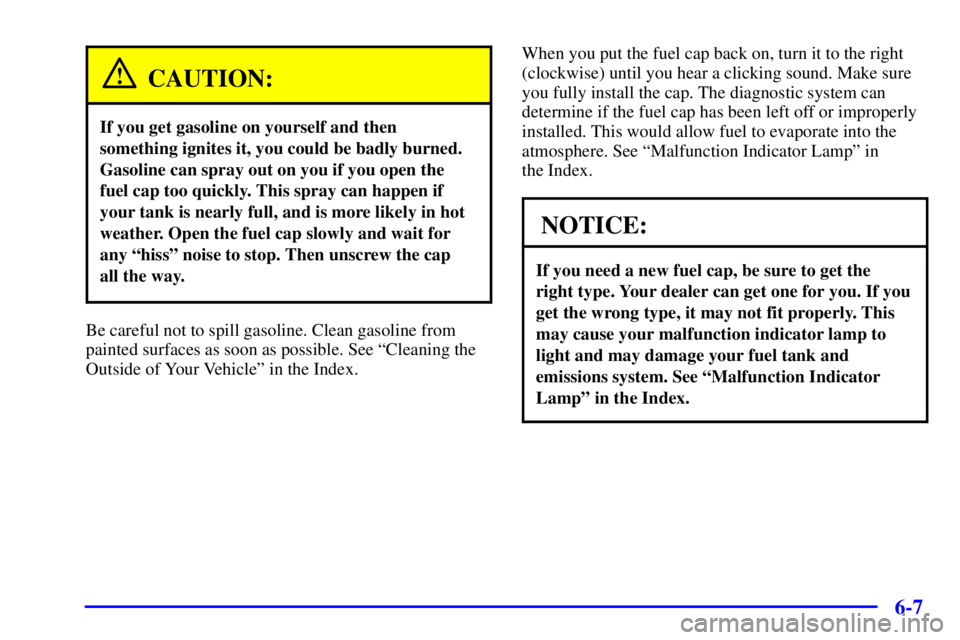Page 253 of 374
5-29 Removing Wheel Covers and
Wheel Nut Caps
If there is a wheel cover,
loosen the plastic nut caps
with the wheel wrench.
They won't come off. Then,
using the flat end of the
wheel wrench, pry along the
edge of the cover until it
comes off.
Removing the Flat Tire and Installing the
Spare Tire
1. Using the wheel wrench, loosen all the wheel nuts.
Don't remove them yet.
2. Turn the jack handle clockwise to raise the vehicle.
Raise the vehicle far enough off the ground for the
spare tire to fit underneath the wheel well.
Page 255 of 374
5-31
For jacking at the vehicle's rear location, put the jack
lift head (B) about 5.5 inches (14 cm) from the front
edge of the rear wheel opening (C) or just behind the
off
-set (A) as shown.
Put the compact spare tire near you.
3. Raise the vehicle by turning the jack handle
clockwise. Raise the vehicle far enough off the
ground for the spare tire to fit underneath the wheel
well. Remove all wheel nuts and take off the flat tire.
Page 257 of 374
5-33
7. Lower the vehicle by turning the jack handle
counterclockwise. Lower the jack completely.
8. Tighten the wheel nuts
firmly in a crisscross
sequence as shown.
9. Reinstall the wheel trim. If the vehicle has plastic
caps tighten them by hand. With a wheel wrench,
tighten the plastic caps an additional quarter
turn clockwise.
Page 260 of 374
5-36 Storing the Spare Tire and Tools
CAUTION:
Storing a jack, a tire or other equipment in the
passenger compartment of the vehicle could
cause injury. In a sudden stop or collision, loose
equipment could strike someone. Store all these
in the proper place.
Compact Spare Tire
The compact spare tire is for temporary use only.
Replace the compact spare tire with a full
-size tire as
soon as you can. See ªCompact Spare Tireº in the Index.
See the storage instructions label on the trunk lid to
properly position your compact spare tire in the trunk.
A. Retainer
B. Cover
C. Compact
Spare Tire
D. Nut
E. Jack
F. Wrench
G. Lock Nut Tool
H. Foam Holder
I. Extension and
Protective Guide
J. Bolt Screw
Page 268 of 374
6-6
Filling Your Tank
CAUTION:
Gasoline vapor is highly flammable. It burns
violently, and that can cause very bad injuries.
Don't smoke if you're near gasoline or refueling
your vehicle. Keep sparks, flames and smoking
materials away from gasoline.
The tethered fuel cap is behind the hinged fuel door on
the driver's side of your vehicle.
While refueling, let the fuel cap hang by the tether
below the fuel fill opening.
To remove the fuel cap, turn it slowly to the left
(counterclockwise). The fuel cap has a spring in it; if
you let go of the cap too soon, it will spring back to
the right.
Page 269 of 374

6-7
CAUTION:
If you get gasoline on yourself and then
something ignites it, you could be badly burned.
Gasoline can spray out on you if you open the
fuel cap too quickly. This spray can happen if
your tank is nearly full, and is more likely in hot
weather. Open the fuel cap slowly and wait for
any ªhissº noise to stop. Then unscrew the cap
all the way.
Be careful not to spill gasoline. Clean gasoline from
painted surfaces as soon as possible. See ªCleaning the
Outside of Your Vehicleº in the Index.When you put the fuel cap back on, turn it to the right
(clockwise) until you hear a clicking sound. Make sure
you fully install the cap. The diagnostic system can
determine if the fuel cap has been left off or improperly
installed. This would allow fuel to evaporate into the
atmosphere. See ªMalfunction Indicator Lampº in
the Index.
NOTICE:
If you need a new fuel cap, be sure to get the
right type. Your dealer can get one for you. If you
get the wrong type, it may not fit properly. This
may cause your malfunction indicator lamp to
light and may damage your fuel tank and
emissions system. See ªMalfunction Indicator
Lampº in the Index.
Page 272 of 374
6-10 Engine Compartment Overview
When you open the hood of a vehicle with a 3100 V6 (Code J) engine, you'll see:
A. Windshield Washer Fluid
B. Battery
C. Underhood Fuse Block
D. Radiator Fill CapE. Engine Coolant Recovery Tank
F. Power Steering Fluid Reservoir
G. Engine Oil Fill Cap
H. Engine Oil DipstickI. Automatic Transaxle
Fluid Dipstick
J. Brake Fluid Reservoir
K. Engine Air Cleaner/Filter
Page 273 of 374
6-11
When you open the hood of a vehicle with a the 3800 V6 (Code K) engine, you'll see:
A. Windshield Washer Fluid
B. Battery
C. Underhood Fuse Block
D. Radiator Fill Cap
E. Engine Coolant Recovery TankF. Power Steering Fluid Reservoir
(low in engine compartment)
G. Engine Oil Dipstick
H. Engine Oil Fill CapI. Automatic Transaxle
Fluid Dipstick
J. Brake Fluid Reservoir
K. Engine Air Cleaner/Filter